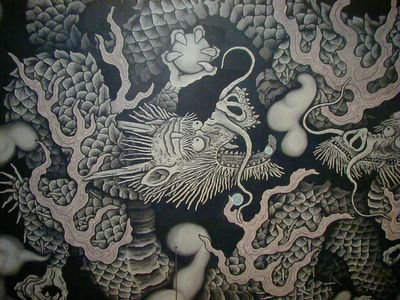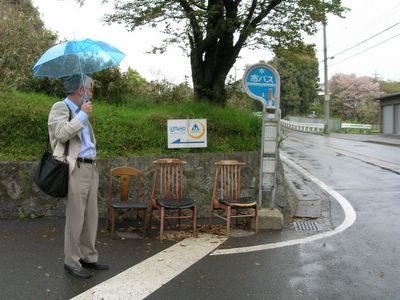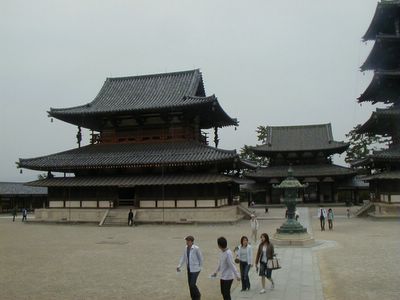
Dragons on the ceiling of the Main Hall.
Monthly Archives: May 2005
Sanjusan-gendo – Longest Wooden Building
One of the buildings we visited in Kyoto was the Renge-o-in, a large temple complex about a mile east of the main railway station. It’s a very popular destination for visitors to the city and is usually called the Sanjusan-gendo or “Hall of 33 Bays” because the building contains 1001 golden life-sized Kanzeon statues on an altar that takes up 33 bays of the building. A ‘bay’ is the space between two pillars
This is one of the biggest temple buildings in Kyoto. The present hall was built in Dogen’s time to replace an earlier building destroyed by fire in 1249. Amazing that such a vast building should have survived wars and earthquakes for 800 years. To house all those statues it is nearly 120 metres (390’) long and 54 feet wide. The thirty-three bays provide a reminder of the number of transformations that Kanzeon is said to employ to save all beings. The main statue on the altar is a double life-size thousand armed Kanzeon flanked by an army of 500 golden Kanzeons on either side. In front are life-sized statues of the twenty-eight guardian deities.
This building is a very powerful representation in carved wood and metal of those opening chapters in many Mahayana scriptures which invoke a vision of the crowds of Bodhisattvas, Devas, Heavenly Guardians and arahants that gather to hear the Buddha teach. The crowds of humans that throng through the long gallery somehow add to this impression. It’s not possible to photograph the statues inside but there are many reproductions of them available in Buddhist art books and I bought a book of stunning photographs in the gift shop.
It’s true Walter (who recommended I visit this place), nothing can prepare one for being in the presence of this array of statues. They fill the space and fill ones being. Put simply, being here ‘blew me away’! The noise and bustle of the visitors, tours guides, children etc. just faded into the background.
Horyuji
Horyuji is the Head Temple of the Shotoku sect.
Horyuji is about 12 miles south west of the city of Nara. The temple was one of the first to be built in Japan and it’s early history is associated with Prince Shotoku who introduced Buddhism to the country. In 1993 it became the first site in Japan to be designated a UNESCO World Heritage site.
Three areas within this very large complex of buildings and grounds covering more than 300 acres are open to visitors. The Saiin Garan (Western Precinct) is the best preserved as a set of buildings and contains what is thought to be the world’s two oldest surviving wooden structures – parts of which survive from the sixth century. The Kondo (Main Hall) houses a bronze Asuka period statue of Shakyamuni cast in honour of Prince Shotoku, and next to it stands the Goju-no-to, (Five Storey Pagoda), another sixth century building.
In the centre of the site is a modern gallery and museum completed in 1998 containing many early Japanese Buddhist statues and other treasures.
The Pagoda
The pagoda.
This was the last temple in a long line of visits in Kyoto and Nara. I must admit I was flagging a bit, however in the museum was an item I have always admired in photographs. The statues, three of them, are on lotuses rising out of a single stalk set against an ornate screen. (anybody know the name of that?) Yes, I was very please to set eyes on that. Latter, as we came upon the museum of temple textiles it was closing time. Too bad.
We had caught the train out of Nara to visit this temple having left our luggage in a locker at the station. As luck would have it we just made the rail connection which took us on to our next destination, Kameyama. The memorable event there was asking at the hotel where we could get onto the internet and being lead at a very brisk pace down the road for a perhaps ten minutes by the man at reception only to realize that he didn’t in fact know of a place…he did try though.
Time for Relaxation.
As well as taking some time to relax after the intensive traveling I have also been attempting to sort out photos of temples and their significants, or special place, in our ancestry. I’ve made some progress and hopefully there will be a lot more pictures published before we leave for China on May 6th. I can hardly say ‘leave for China’ without a slight sense of disbelief creeping into my mind.
There has been lots of activity which I’d love to write about, notably a wonderful visit in Tokyo last evening, however now it’s 1.05 am and I’d better go to bed.
I have published the photo below for no good reason except that I like it. The concept of people bringing their own seating arrangements to wait for a bus and then leaving for others is an interesting one.

Iain and three chairs waiting at the bus stop near the hostel in Kyoto.


